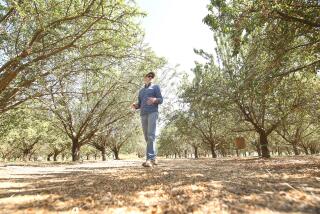Chestnut Trees May Once Again Grace Eastern Avenues if Fungus Vaccine Works : Vaccine May Resurrect U.S. Chestnut Tree
- Share via
NEW HAVEN, Conn. — American chestnuts could once again line Eastern avenues if an experimental vaccination technique proves successful against the fungus that devastated the stately trees three decades ago.
Two stands of trees treated 10 years ago by the Connecticut Agricultural Experiment Station are not only thriving and producing tasty nuts, but their fungus resistance appears to be spreading to other chestnuts.
The treatment involves injecting the trees with a mixture, imported from Europe, of a virus-like substance and the killing fungus. The substance doesn’t kill the fungus, but makes it less effective--sort of a vaccination.
“I think we have a real phenomena. I think we have the spread of a biological control,” said Sandra L. Anagnostakis, who has studied the American chestnut for more than 20 years. “But how far will it go?”
Anagnostakis speculates that insects, animals or people are spreading the weakened fungus to other trees, allowing them to survive too.
A control for the fungus could add a new chapter to the story of one of the great environmental disasters of modern time.
American chestnuts once grew from Georgia to Maine. Their dominance in the woods made them prized for food and wood. And because all but the oldest trees put out new sprouts when cut, replanting wasn’t required after harvesting.
But in 1904, the chestnuts that lined the avenues in New York City’s Bronx Zoo began to wilt and die from a fungus that couldn’t be stopped.
“The infection was insidious, and the fungus was able to spread out very rapidly from its apparent start in the New York area,” Anagnostakis said.
By the 1950s, all mature chestnuts in the native range had been wiped out, an estimated 3.5 billion trees.
Anagnostakis suspects that the fungus, Cryphonectria parasitica , was brought into this country with Asian chestnut trees from Japan or China at the turn of the century. But it causes few problems for Asian chestnuts, possibly because the fungus and Asian chestnuts evolved together.
“The American chestnut is a different species,” she said. “It had never been exposed and was almost completely susceptible. It’s partly because of that that we now have plant quarantine laws.”
Scientists have been able to study American chestnuts because the trees produce sprouts from stumps or old root systems. The fungus doesn’t penetrate below ground and into the roots, so the trees can grow as large as six inches in diameter before the fungus infects and kills them.
The fungus usually enters a tree through a broken branch or a break in the bark. It then grows through the cambium, the growing tissue that produces bark and wood, and eventually pushes through the bark to appear as orange blotches.
The blotches produce spores that help spread the fungus.
European chestnuts are similar to American and also are susceptible to the fungus, which was first reported overseas in Italy in 1938. It began to spread rapidly, but within 15 years a variation of the fungus was discovered in Italy that was less virulent and appeared to stop the killing blight when the two came together.
French scientists Jean Grente and Suzanne Sauret began studying the less deadly strains, known as “hypovirulents.”
In 1972, Anagnostakis got a sample. She said they haven’t identified the hypovirulence, but that it acts like a virus and contains double-stranded ribonucleic acid.
In 1978, researchers introduced the Italian strain in test sites in Goodwin State Forest in Hampton, Conn., and on private land in Pomfret, and Anagnostakis has tested different mixtures of it at other sites across the state.
In all cases, the trees seem to be surviving and the hypovirulents are spreading. The treated trees don’t grow straight and tall like their ancestors, and probably never will because the hypovirulents create cankers, big knots of bark, that grow on the trees, she said. The cankers don’t kill the trees.
Anagnostakis’ research is unfinished, but she is “guardedly optimistic about the biological control in our woodlands.”
More to Read
Sign up for Essential California
The most important California stories and recommendations in your inbox every morning.
You may occasionally receive promotional content from the Los Angeles Times.










